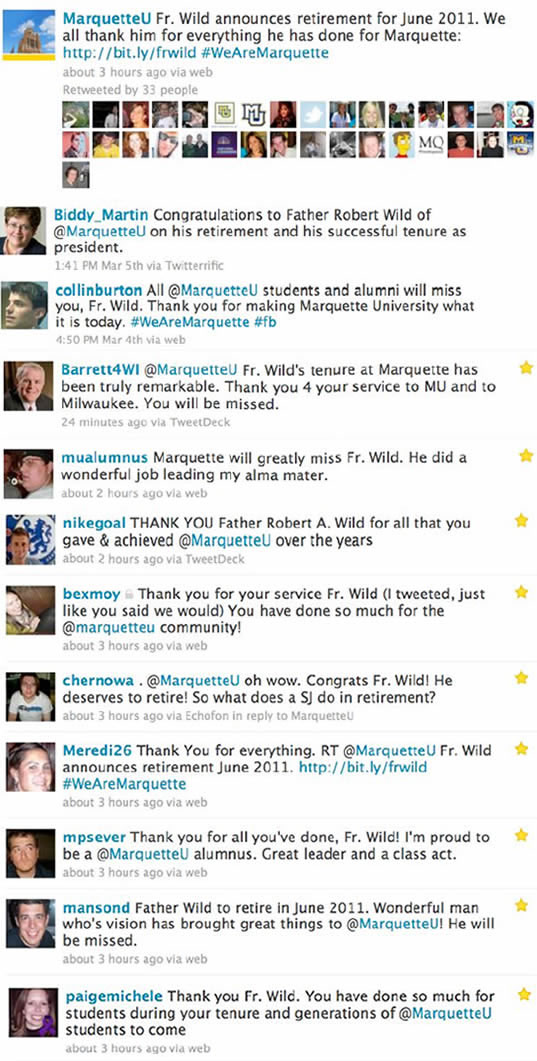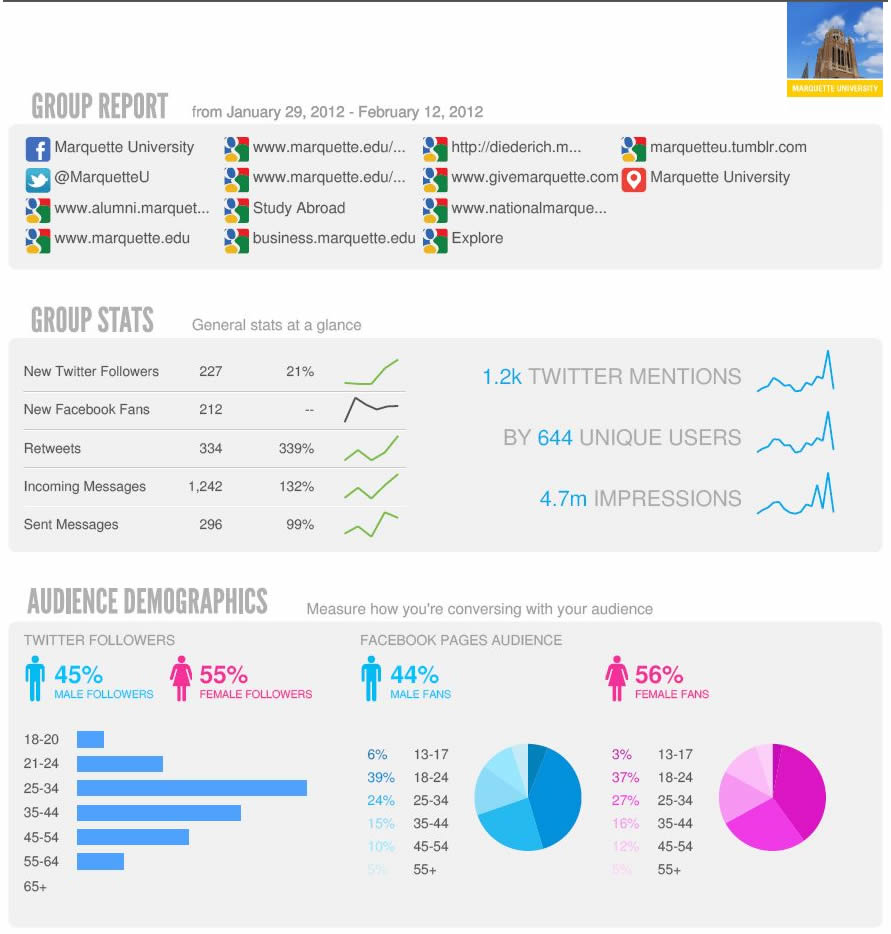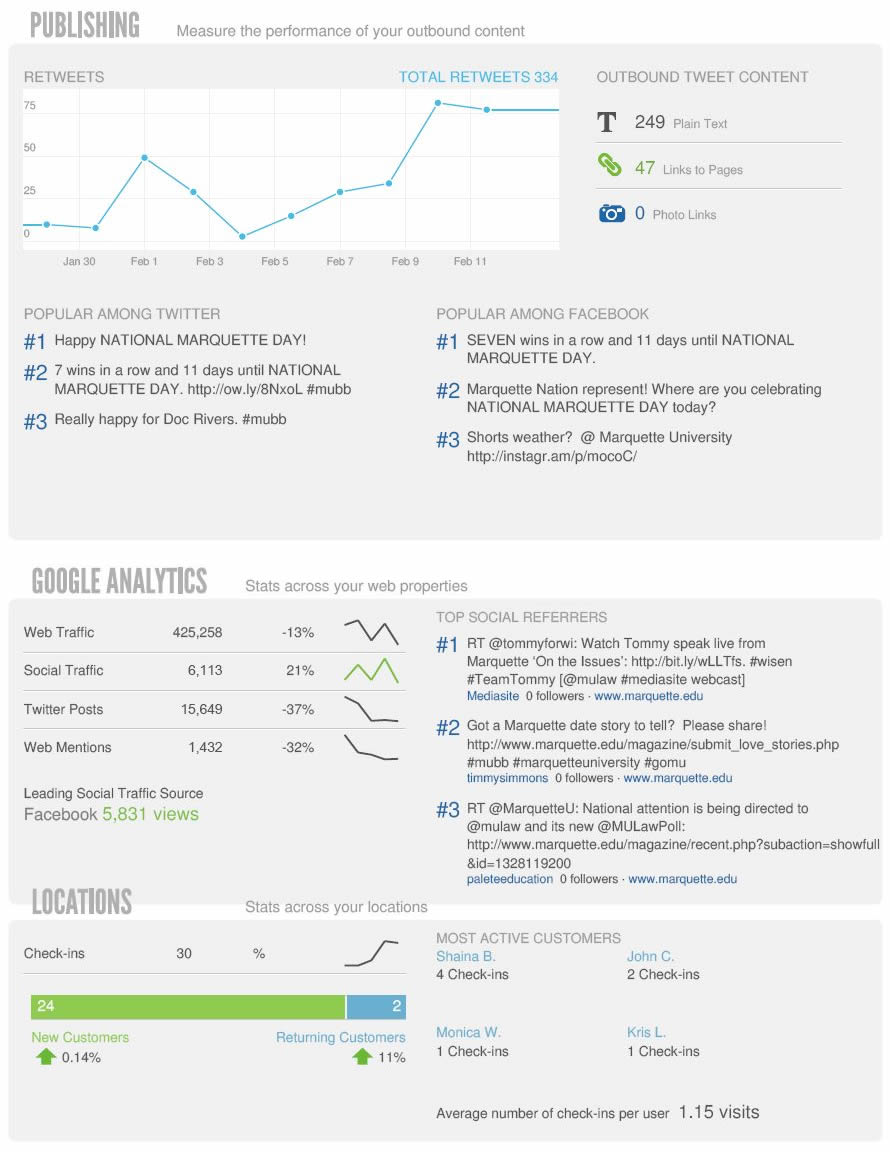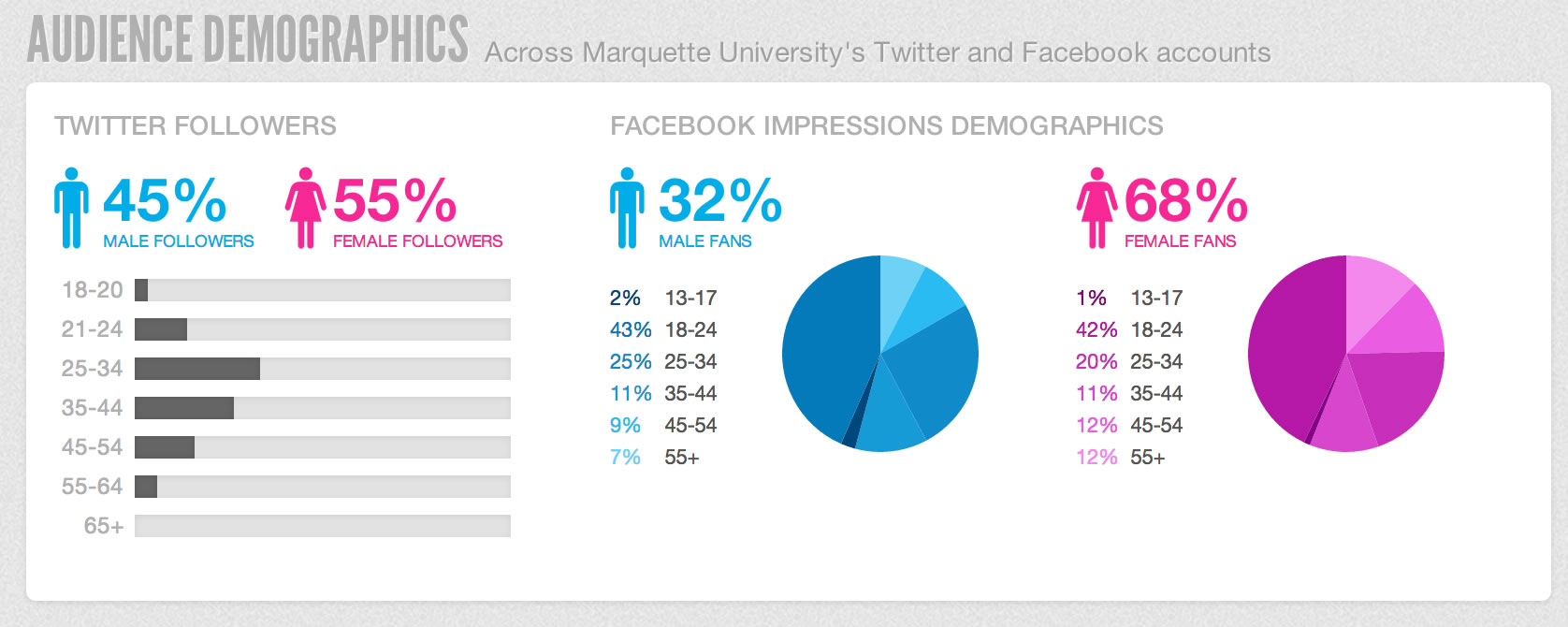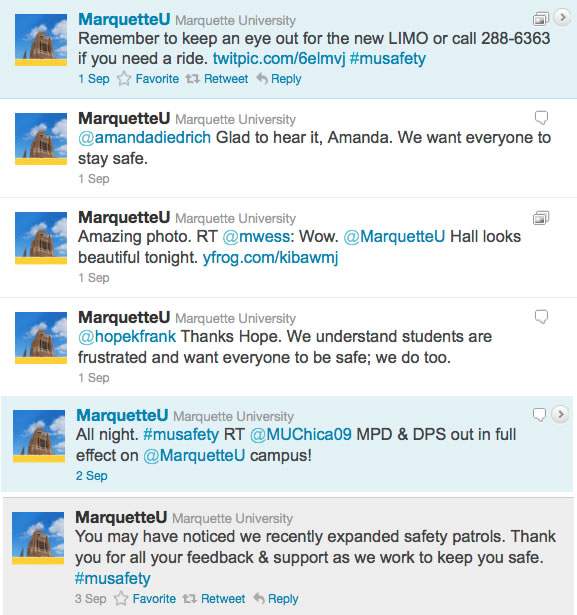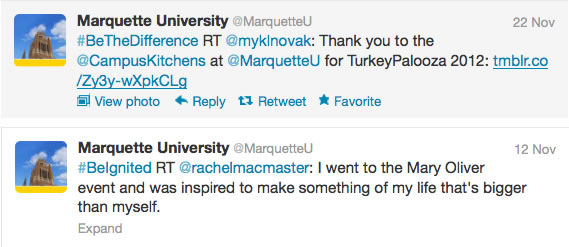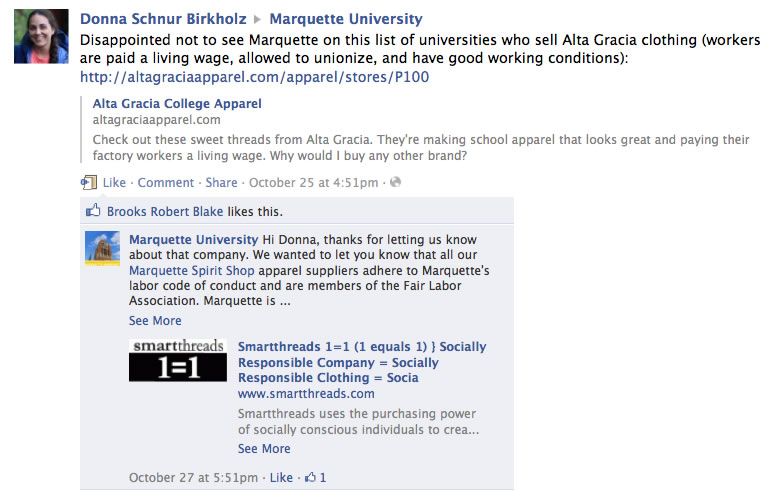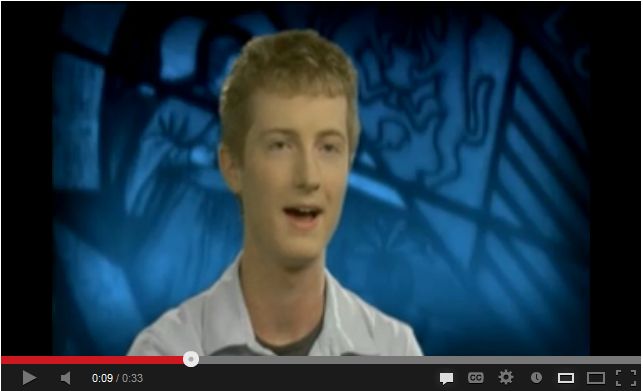To cite this article
Stageman, A. & Berg, K. (2013). Friends, fans, and followers: A case study of Marquette University’s use of social media to engage with key stakeholders. Case Studies in Strategic Communication, 2, article 2. Available online: http://cssc.uscannenberg.org/cases/v2/v2art2
Access the PDF version of this article
Friends, Fans, and Followers:
A Case Study of Marquette University’s Use of Social Media to Engage with Key Stakeholders
Amanda Stageman
Kati Berg
Marquette University
Abstract
This case study examines social media as a relevant marketing strategy for one higher education institution. As an innovator of social media strategy for colleges and universities, Marquette University is showcased because of the school’s early adoption of a social media strategy and its commitment to connecting with key stakeholders through social media websites. Marquette is one of few universities that continuously engages in conversations with its followers via social media, active in 10 different social media platforms through which the university engages with various stakeholders. In this case study, social media use among academic institutions is reviewed to provide background. Strategy, tactics, and measurement approaches are explored through one-on-one interviews with members of the Office of Marketing and Communication at Marquette University. The case study concludes with an analysis of how social media efforts may directly contribute to building the Marquette University brand. The insights derived from this case study are useful in helping communication and marketing professionals in higher education better understand and apply social media practices to build relationships with key stakeholders.
Keywords: higher education; social media; managing relationships; dialogue; engagement
Overview
Beginning in 2007 academic institutions started to build a presence on social media sites as a strategy to connect with current students and to reach prospective students. For example, Reuben (2008) argues that Twitter can be used for “awareness and branding, promoting your content, fast feedback, finding new audiences, and marketing – all areas marketers in higher education should have great interest in” (p. 5). Swartzfager (2007) and Wilburn (2008) have suggested additional uses for Twitter, such as in emergency situations, such as school shootings, or using it in place of a live chat service for recruitment.
In November 2007, Facebook created “the fan pages concept,” which allows users to become a fan of any type of organization or cause, and “many universities jumped at the opportunity to create an official Facebook presence for their university” (Reuben, 2008, p. 3). Participation in two-way dialogue is one of the distinct features that differentiate social media sites from more traditional media. Reuben (2008) argues that social media “can assist in clearing up misconceptions and promote unsolicited, genuine positive feedback, which is invaluable to prospective students and marketers alike,” allowing for more trust than traditional advertising would provide (p. 8).
A university is a particularly interesting context in which to examine how social media is used, because, unlike other industries, institutions of higher education have unique and diverse segmented audiences, including prospective students, current students, and alumni, and the generational differences, styles, and needs of each group tend to be very different.
Why a Focus on Marquette University?
Marquette University is among a few academic institutions that have been recognized for their integration of social media into overall marketing and communication strategy and innovative use of social media to fully cultivate impact with key stakeholders (Ward, 2010; Luckerson, 2012; PRNews, 2012). Not only is Marquette much more active than most universities using social media (Ward, 2010), it was also an early adopter in the social media landscape (PRNews, 2012). According to a July 2009 report by the marketing firm Blue Fuego, Marquette ranked 10th in the nation among mid-sized universities for its number of Facebook fans (Ward, 2010). Tim Cigelske, Director of Social Media at Marquette University, notes that social media can be a challenge for universities because they tend not to be the most nimble enterprises, and university administration can be distrustful or fearful of new technologies (personal communication, April 3, 2012). However, Marquette embraced social media as early as October 2008 and uses integrated social media networks, such as Facebook, Twitter, YouTube, Foursquare, Flickr, Tumblr, Google+, Pinterest, and Instagram to connect with students, faculty, and alumni.
In 2011, Klout, a social media monitoring service, ranked @MarquetteU as one of the top 10 most influential university Twitter accounts in the country. Additionally, Forbes.com recognized Marquette University as the most active Twitter user among colleges and universities, “with more than 10,000 tweets, leading all Big East schools in number of Twitter followers, with more than 12,000 followers” (“Marquette University in the News,” 2011, para. 4). Furthermore, BlueFuego, in its study of more than 2,000 higher education Twitter accounts, characterized Marquette’s Twitter account as “very conversational” (Type 5), and one of a handful of accounts that fall in the top 10 percent of the U.S. higher education institutions for the number of followers, number of accounts followed, number of updates, and number of mentions (Ward, 2010). “It’s obvious that staff members are actively monitoring the account and sharing a wide range of information through updates, including links, photos, and videos” (Ward, 2010, para. 12).
The following case study outlines how the marketing and communication team at Marquette University incorporated a social media strategy that complements the current traditional communication efforts and branding strategy for the university and strengthens relationships with key stakeholders.
About Marquette University
Named after Rev. Jacques Marquette, S.J., a French missionary explorer, Marquette University is a Catholic, Jesuit institution located in Milwaukee, Wisconsin. There are approximately 8,400 undergraduate and 3,600 graduate and professional students enrolled with nearly all states and 68 countries represented. Marquette University offers undergraduate students approximately 116 majors, 65 minors, and pre-professional programs within eight different colleges: Arts and Sciences, Business Administration, Communication, Education, Engineering, Health Sciences, Nursing, and Professional Studies. Marquette also offers 50 doctoral, master’s degree, and certificate programs within its graduate school, as well as a law school and school of dentistry.
Marquette University was founded on Jesuit traditions and the belief in “Cura Personalis,” which means care for the entire person.[1] The university’s mission is “the search for truth, the discovery and sharing of knowledge, the fostering of personal and professional excellence, the promotion of a life of faith, and the development of leadership expressed in service to others. All this we pursue for the greater glory of God and the common benefit of the human community” (”About Marquette: Our Mission,” n.d.). Marquette’s tagline, “Be The Difference,” represents the university’s goal to “help students and the entire Marquette community become the kinds of leaders who will make important contributions as men and women for others—who will Be The Difference in their communities” (“About Marquette: Logo and Seal,” n.d.). Marquette University also uses the tagline “We Are Marquette,” in reference to both athletics and a strong and close-knit community of students and educators.
Marquette’s Social Media Background
In addition to its traditional marketing channels, such as television advertising, printed literature, outreach to high schools, and fundraising events, the university has embraced social media and fully integrated it into its marketing and communication strategy as a powerful tool for communicating with the university’s key audiences. Specifically, Marquette University maintains multiple official Twitter accounts, one Flickr account, one YouTube channel, a Foursquare page, several official Facebook pages, a Tumblr site, a LinkedIn account, a Google+ account, a Pinterest pinboard and two Instagram accounts. These accounts receive a considerable amount of participation from online audiences, as observations in April 2012 revealed while gathering the following numbers.
The main Twitter account, @MarquetteU, has more than 15, 500 followers; the Marquette YouTube channel has received more than 693,000 video views and 535 unique subscribers; the Marquette University Flickr account holds 68 photo sets with more than 115,000 views of campus, special events, alumni and more; it has the 10th-most popular university Foursquare profile in the country with more than 50,000 check-ins, 15,700 followers, and its own Be the Difference badge; and more than 20,400 people from more than 25 countries around the world are fans of Marquette on Facebook, from Malaysia to Ghana to Australia, and beyond.
It is important to note that these figures only represent official university-wide accounts and do not include social media sites that are managed by individual colleges or programs. It is evident that Marquette University is extending a major effort and commitment to connect with key stakeholders through social media websites. For comparison, in January 2010, when the use of Twitter among major colleges and universities started gaining more popularity, Marquette University’s Twitter following was comparable to more well known schools, such as Harvard University and Boston College, who had Twitter followings of 6,807 and 5,989, respectively. With 5,534 followers, Marquette University was far outpacing its regional counterparts, such as University of Wisconsin-Madison’s 2,697 followers, Loyola University Chicago’s 1,878 followers, University of Wisconsin-Milwaukee’s 1,683 followers, and University of Notre Dame’s 1,442 followers (personal communication with Tim Cigelske, October 26, 2012).
Marquette University’s social media strategy was designed to appeal to each group of stakeholders, including prospective students, current students, and alumni. As a result, the university has shaped social media around the unique needs of each group; for example, a Facebook group staffed with tour guides for incoming freshman and the Give Marquette campaign to remind older alumni of their years on campus. Students and alumni are passionate about their universities and, thus, are more likely to develop deep relationships with the university that can be cultivated via social media. Interviews were conducted with key players in Marquette’s Office of Marketing and Communication to gain a better understanding of the university’s overarching strategy and more knowledge about how the examples outlined were inspired.
Research
In order to best understand how Marquette University utilizes a social media strategy to engage with and build relationships with stakeholders, interviews were conducted with four different professionals who are responsible for the social media strategy and who have first-hand knowledge and experience with social media at Marquette University. The semi-structured interview technique was used, which allows “interviewers to ask a set of basic questions on the interview schedule, but they are free to ask probing follow-up questions as well, usually to gather specific details or more complete answers” (Frey, Botan, & Kreps, 2000, p. 101). Some of the major advantages of interviews are that they provide researchers with a depth of knowledge about the respondent, allow for clarification and follow-ups, and allow the researcher to observe both verbal and nonverbal behavior of respondents (Frey, Botan, & Kreps, 2000).
The respondents represented relevant departmental positions that have the most experience with social media at Marquette University, including the Vice President of Marketing and Communication, the Director of Social Media, the Director of Interactive Marketing & Digital Strategy, and an Undergraduate Admissions Counselor. One 45-minute interview was conducted with each respondent, with the potential for up to 30 minutes of follow-up via either e-mail or telephone when it was necessary. After transcriptions were produced of each interview, constant comparative method was used to determine key themes behind Marquette University’s strategic social media plan.
Strategy
According to Tom Pionek, Director of Interactive Marketing & Digital Strategy, Marquette’s social media strategy started with a simple marketing principle in mind: go to where the audience is. Marquette’s marketing and communication team understood the value of creating content that the university’s target audiences would find engaging. Pionek notes:
Our department started to recognize a need for engagement in social media and it stems primarily from the fact that we knew our audience was engaged in social media. We decided we needed to get engaged and the way to do it right was to have a communication plan around it. (personal communication, April 9, 2010)
In fact, the marketing and communication team believed that creating relevant, interesting content for this specific communication channel was so vital for the success of Marquette’s social media brand, that a social media coordinator for the school was hired in 2008 based on journalism and storytelling experience, rather than simply having the most up-to-date technology skills. Tricia Geraghty, Vice President of Marketing and Communication, explains:
We said from the very beginning, from a strategic perspective, that the primary skill set we needed in this was not the technology; it was the person who had storytelling ability and who knew about content and what would be interesting to people. We set out to hire somebody who had a reporting or journalism background or a communications background. We needed them to be savvy and knowledgeable about how to use new media, but the trump skill was to be understanding of story and emotion, connecting people, and building community. (personal communication, September 16, 2010)
Once the social media coordinator was appointed to the marketing and communication team, a strategic social media approach was developed.
According to Marquette University’s strategic social media plan (Marquette University Office of Marketing and Communication, 2010), the key target audiences include prospective students, current students, alumni, and parents. The goals of the strategic social media plan are to build awareness for the Marquette brand online, to build a sense of community among target audiences, and to foster word-of-mouth communication. From a strategic perspective, Marquette seeks to disseminate information and tell stories via social media outlets, including Facebook, Twitter, Flickr, and YouTube, that will engage multiple key audiences.
According to the Office of Marketing and Communication (“Social Media at Marquette,” n.d.), it makes strategic sense for Marquette to be involved with social media because:
- Good communication practice dictates that we use all methods to engage our audiences wherever they are.
- There are already conversations about Marquette in social media, and our participation allows us to lead the discussion that defines our brand.
- Social media is an innovative communication channel and allows us to position the university as an innovator among our peers.
- Social media gives us the ability to interact directly with our audience and connect our audience with each other, which is key to building engagement.
- Social media allows us to drive and harness the power of word of mouth—the buzz factor—which is perceived as more credible and authentic than traditional marketing materials.
According to Geraghty, the initial goal of the University’s social media strategy was to “be an active player in it and build a sense of community, characterizing more broadly what the Office of Marketing and Communication is about, with social media as an extension of that” (personal communication, September 16, 2010). However, this broad goal quickly evolved into a specific, measurable objective: to achieve interaction with five percent of the audience within a given channel in any month and to reach 35,000 people on all University accounts. Since the social media initiatives were very recent and no prior baseline existed, the social media team created its own baseline and believed the five percent interaction was a reasonable goal.
Execution
According to Cigelske, the social media efforts that Marquette employs should always be used as an extension of what the University is already doing in terms of marketing and communication. Cigelske explains:
One of the most important things to keep in mind with social media is that it is not something separate from everything else that you do. While social media acts differently—it’s faster than other forms of communication and it can amplify things and it can build a pretty visible community—you should have the same goals in social media that you do elsewhere. So basically whatever else you’re doing in different aspects of the business or university, it should just be reflected in social media. (personal communication, February 12, 2010)
For example, when Marquette sponsored its annual “National Marquette Day” in January, social media tactics, such as a Marquette pride photo competition on Flickr, were incorporated into an integrated campaign that used many different branches of promotion. Although social media was incorporated in the promotion of National Marquette Day, there were also many traditional tactics, such as costume contests, games, reunions and prize giveaways around campus. The combination of both online and traditional promotions helped to create a university event that engaged alumni and current students, as well as helped prospective students have interaction with Marquette University. According to Theunissen and Wan Noordin (2012), “Ideally, organizations should foster greater public interaction using the mass and new media, and have a procedural approach to dialogue by establishing practices that facilitate the organization-stakeholder dialogue” (p. 10).
Not only does the marketing and communication team seek to create relevant and interesting content that the target audience could respond to, they also discussed the importance of creating dialogue. Whether the target audience is reacting to posted content or reaching out to the school on their own, allowing the opportunity for open dialogue was another important issue for the marketing and communication team. Mersham, Theunissen, and Peart (2009), Henderson and Bowley (2010), and Li (2010) have all emphasized the importance of fostering dialogue in social media efforts, as dialogue “has become ubiquitous in public relations writing and scholarship, and even more so in the light of the ever-evolving Internet and its social media application” (Theunissen & Wan Noordin, 2012, p. 5). Mersham et al. (2009) explain, “Public relations will be increasingly about dialogues and conversation rather than traditional one-way monologues of the past, adapting to the free exchange of opinions across groups and collectives that previously were merely recipients of communication messages” (p. 10). One specific example of how Marquette University often creates and fosters dialogue is through viral videos. Pionek points out:
Figure 1. Twitter dialogue in response to Father Wild’s retirement.[The marketing team] occasionally produces content that is directly for social media, like remixed reactions from social media into a video—which I think is just brilliant on extending the dialogue. You have an event, such as Father Wild retiring, when the school makes the announcement, we post the video of the speech. When people react online, [a marketing and communication team member] takes the reactions and makes a video, posts [that video], and people react again. It’s a great dialogue. (personal communication, April 9, 2010; see Figure 1)
Additionally, Marquette uses Twitter to foster dialogue and connect people within the Marquette community. Cigelske explains:
Figure 2. “Welcome to Marquette” video featuring tweets from incoming and returning students excited to start the school year. Click the screen shot to view the video on YouTube.Last summer, people started talking about being excited to get back on campus or looking forward to coming to Marquette for the first time. They would send these tweets out saying things like, “I can’t wait to be on campus.” I started seeing these pop up over and over again so I started taking screen shots of them. It was a mixture of current students and new students. I created a video featuring all of the quotes and called it “Welcome to Marquette.” Things like that help to show some sense of excitement from a big community of people. (personal communication, February 12, 2010; see Figure 2)
Although social media is often used in combination with other large integrated campaigns for the University, it should be noted that there are times when special content is created solely for social media. For example, specific social media tactics are often posted on various social media outlets and specialized groups and forums, such as the Class of 2014 Facebook page, in which current Marquette students are able to connect with and help answer prospective students’ questions about life at Marquette. Pionek notes:
In essence, we know that prospective students were going online as soon as they got their acceptance letter and forming a group about being the new incoming class at Marquette. I watched that for two years and inevitably they would end up asking each other questions that none of them know the answers to. So I pitched the idea that we should start a group for them, and then we would be in a brokerage situation where we’re acting as a bridge between two people interacting—and there is value in doing that. (personal communication, April 9, 2010)
In order to help facilitate the student connections, Leah Strong, the Admissions Counselor who is the primary manager of the Class of 2014 Facebook group, acts as “the middleman that connects the current student to the student that has posted a question or has concerns about Marquette.” One of the contributing factors that help the Marquette Class of 2014 Facebook group succeed is the strong sense of community that the group’s facilitators try to foster among its members. In addition to sharing excitement and bonding with other students, this type of open discussion also allows students, prospective students in particular, the opportunity to ask questions and hold conversations with individuals at the University in ways that are not always possible in traditional school visits. (Stageman, 2011).
Evaluation
The marketing and communication team measures effectiveness based on the level of engagement, or interaction rates, from each post on all social media accounts. Examples of how the marketing and communication team measures engagement in posts include sharing, posting, commenting, or tagging content in each specific social media platform, keeping in mind how the metrics fit within the bigger context. For example, major campus events, such as the announcement of a new university president, tend to increase interaction rates, including likes, comments, follows, mentions, and retweets, and Marquette regularly exceeds the goal of five percent interaction. In fact, interaction has been as high as 30 percent during the height of basketball season.
The university uses Sprout Social to track quantitative metrics. Sprout Social helps organizations manage their interactions with customers on social networks. A report of the two weeks leading up to National Marquette Day (January 29 through February 12, 2012) gives a snapshot of the quantitative metrics the team uses to analyze and evaluate its social media platforms (see Figure 3). Although important in terms of numbers, reliance on quantitative data does pose a limitation. Even though the team does gather informal feedback, the marketing and communication team should integrate formal qualitative measures to ensure a more balanced analysis of its social media activities.
Figure 3. Social media report from Sprout Social in the two weeks leading up to National Marquette Day 2012.Although the marketing and communication team uses specific goals and strategies for social media in the strategic planning process, an important focus for the team is to make sure that all social media efforts fit seamlessly with any other marketing tactics.
Having a bridge to connect current and prospective students seems to make a positive impact on students’ college searching experience. According to Cigelske:
We’ve had more informal feedback from students about social media. We did something called the Freshman Video Project, where we gave flip cameras to seven incoming freshman to document from when they were admitted to when they came to campus. We then had them share their reflections on video with us about what worked, what didn’t work, what helped them, and what wasn’t so helpful in settling into campus life. They were very honest. It was a video diary of sorts. Overwhelmingly, what people said helped [with their transition] the most was Facebook. It was not just because they were able to quickly get answers to questions or that they had access to Admissions Counselors, but more that whatever questions they had and whatever they were feeling, everyone else was feeling too. (personal communication, February 12, 2010)
On the University side, professionals from both the Office of Marketing and Communication and the Undergraduate Admissions Office strive to fully integrate social media tactics with all of the other promotional branches used in the university’s marketing strategy. Marketing and communication team members believe that one of the reasons why incorporating social media into the university’s marketing mix has been successful is because the advantages that social media channels offer, such as the ability to connect communities of people, fit naturally with the existing Marquette University brand. In order for schools to be able to successfully use social media to connect with key stakeholders, such as prospective or incoming students, the characteristics of social media must first align with what the school is already doing in terms of marketing and branding. The success of Marquette’s social media strategy, measured by the school’s ability to engage with social media users and promote school pride, has been recognized externally and endorsed by multiple media outlets for learning to leverage the benefits of social media (Davis, 2012; Lepi, 2012; “Top Colleges,” n.d.). As a result, Marquette’s Foursquare profile has become the 12th most popular among universities with nearly 2,000 “friends,” according to FanPageList.com (“Top Colleges,” n.d.). It was also named one of the top five Pinterest accounts in higher education by edudemic.com (Lepi, 2012) and recognized by the Milwaukee Business Journal as one of the top 20 social media brands in the area (Davis, 2012).
However, not everything Marquette does is a huge success. For example, this past spring the marketing and communications team tried to do an “Ask Father Pilarz” on Twitter where students could pose questions to University President Father Pilarz. The initiative did not get much traction, with less than 15 tweets, whereas a big response usually elicits at least 50 or more tweets, so the team put it on hold for now (Cigleske, personal communication, April 3, 2012). Cigelske notes that timing might have been off since the first effort took place during midterm week and the second was right after spring break during March Madness. The team plans to try it again, but if it does not get the expected outcome of at least 50 or more tweets from followers, it is not a big setback because social media is naturally high interaction and low risk. He explains:
Part of the benefit of social media is that you can try something and if it doesn’t work, you’re not out a whole lot because you didn’t put a lot of time and effort into it. Social media allows you to try and fail, and that’s okay. It is very different from a big print or TV campaign in that regard. You obviously want to be as compelling as possible, but part of the social media strategy is to put things out there and see what resonates then continue to put efforts behind what is picking up steam. (personal communication, April 3, 2012)
Analysis & Discussion
After interviewing the four key players who are primarily responsible for the planning and implementation of Marquette University’s strategic social media plan and observing the social media strategy and tactics, four key topics emerged: engagement, dialogue, bridging of information, and community.
Engagement
When social media content is successful, open dialogue between the University and current or prospective students is often the result (Kent, Taylor & White, 2003; Mersham et al. 2009). In fact, one of the main benefits of social media is the enabling of direct engagement with brands (Paine, 2009). However, some scholars have debated the difference between passive following and active engagement in social media. The topic often sparks discussion because of the varying definitions of engagement. The public relations industry has not yet established a widely accepted definition of what engagement means and how to best measure it. The importance of understanding what engagement means and how to best measure it lies in the power of relationships. Social media “enable consumers to connect with others by exchanging information, opinions and thoughts about brands,” demonstrating the power of word-of-mouth and opinion-passing behavior (Shu-Chaun & Yoojung, 2011, p. 48). How people feel about a specific organization or brand influences how they voice opinions online, and their “willingness to share content with others is extremely useful in increasing brand engagement and relevance” (Shu-Chaun & Yoojung, 2011, p. 50; see also Paine, 2009).
Mersey, Malthouse, and Calder (2010) underscore the importance of an organization’s understanding of engagement as a way to create value for consumers and set its brand and social content apart from others. As such, they define engagement as the collective experiences that consumers have with a brand. Engagement, in turn, helps create an experience, which is “a specific set of beliefs that consumers have about how some brand fits into their lives” (p. 40). Measurement expert Paine (2009) argues that the only way to effectively measure engagement is not by analyzing the number of stories, posts, tweets or videos that the organization publishes online, but rather how people react to that content. In other words, engagement should be tracked by number of comments, shares, mentions, ratings, followers, and fans. Paine (2009) argues that this metric is especially powerful when compared using a ratio of postings to comments and responses, similar to how Marquette’s marketing and communication team evaluates the effectiveness of their efforts.
Engaging with a variety of audiences via social media allows Marquette University to become part of the community and further extend its brand to those who are not physically on campus. Furthermore, this strategy is far removed from traditional communication efforts that simply broadcast a single message to a mass audience. Rather, the university seeks to engage in listening and bonding with multiple groups of people via social media. For example, Cigelske can create custom Facebook posts for Marquette fans in certain cities that are of particular interest to those people rather than posting 50 different messages. Thus, when promoting National Marquette Day, Facebook fans in Minneapolis see a custom post with viewing information that is different than the post for Marquette fans in Dallas (see Figure 4).
Figure 4. Tailored Facebook posts for different locations.Additionally, Cigelske uses Twitter to listen to and address concerns from stakeholders. Recently, there was confusion about the future of the Freshman Frontier Program (FFP) at Marquette University. The university was able to address these concerns by speaking directly to those stakeholders who wanted answers about the program (see Figure 5).
Figure 5. Marquette staff responding directly to stakeholders’ questions about the Freshman Frontier Program on Twitter.Grunig (2009) cautioned about the use of new media saying, “many practitioners are using the new media in the same ways they used the old—as a means of dumping messages on the general population rather than as a strategic means of interacting with publics and bringing information from the environment into organizational decision-making” (p. 1). At Marquette, practitioners understand the importance of engaging with multiple publics to create interactivity and dialogue (Galloway, 2005).
Dialogue
Whether the target audience is reacting to posted content or reaching out to the school on their own, the marketing and communications team attempts to create an opportunity for open dialogue (Deetz, in Heath et al., 2006) that will connect people from all corners of the university community. A social media community demographic analysis of Marquette University’s Facebook and Twitter accounts by Sprout Social indicates that 68% of Facebook impressions come from females and 55% of the university’s Twitter followers are female. The majority of Facebook fans are between the ages of 18 and 24 years old, while 25-44-year-olds make up the majority of its Twitter followers (see Figure 6).
Figure 6. Social media demographic data from Sprout Social.For prospective students in particular, having the ability to share excitement and bond with other students, as well as ask questions and hold conversations with university representatives, gives prospective students unprecedented access to the university before even stepping foot on campus. Creating dialogue via social media has enabled Marquette University to better connect with and strengthen relationships with current students, prospective students, parents, alumni, and members of the community. This is especially important to Marquette since it relies on its students and alumni to achieve its mission (Kent, Taylor, & White, 2003). In fall 2011, the university used Twitter to seek feedback from students and faculty about how to address a rash in robberies on or near campus. Thus, social media was implemented as an issues management strategy that created much needed dialogue between the university and the campus community (see Figure 7).
Figure 7. Twitter dialogue to address campus robberies.Bridging of information
Several studies have found that universities and nonprofit organizations lack dialogic technologies and interactivity (Chung, Lee, & Humphrey, 2010; Gordon & Berhow, 2009; McAllister & Taylor, 2007; Waters, Burnett, Lamm, & Lucas, 2009). Waters et al. (2009) noted organizations “were not taking advantage of all the options the site had to offer their relationship cultivation efforts” (p. 105). According to McAllister and Taylor (2007), a feedback loop must be present and followed through with two-way communication for dialogic communication to take place. Marquette’s integrated social media strategy emphasizes interactivity and dialogue to cultivate relationships with key stakeholders. For example, the university congratulates accepted students via Twitter on decision day (Luckerson, 2012). Additionally, it is common for faculty, students, and alumni to receive retweets from Marquette University’s Twitter account (see Figure 8). This fall a high school student created a video about why she wants to attend Marquette University. Although she is not yet a student, the university reached out to her and shared her video across multiple social media platforms, including Facebook, Twitter, and Tumbler, to build a personal relationship with her (see Figure 9).
Figure 8. Retweeting others is a common practice for Marquette’s Twitter account.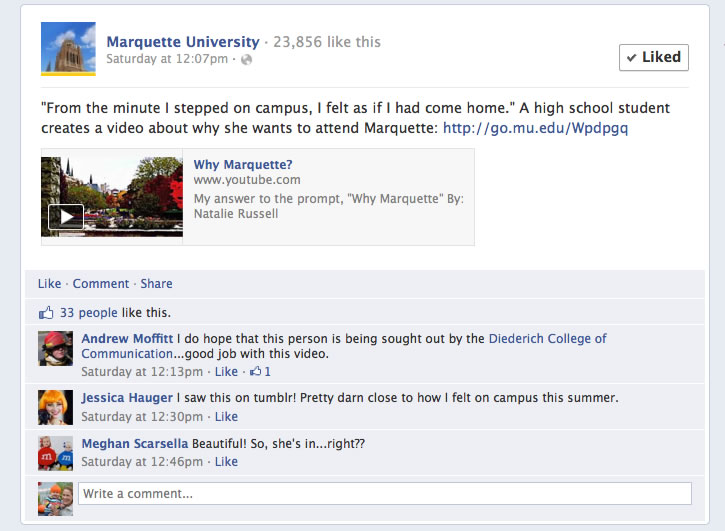 Figure 9. Marquette shared a video from a prospective student on its Facebook page.
Figure 9. Marquette shared a video from a prospective student on its Facebook page.
Although printed literature and campus visits are common resources for students to use when making a college decision, being able to talk with and pose questions to current students is something of high value to prospective students (Stageman, 2011). Current students are able to provide eager incoming hopefuls with more honest and accurate depictions of student life on campus as they have experienced it. Social media also enable the university to serve as the information bridge. When a Marquette alumna posted on the Marquette University Facebook page to say she was disappointed that Marquette was not listed as a retail outlet for a specific brand of fair trade college apparel, Cigelske was able to directly address her concern and then provide information about the Spirit Shop’s policies and practices on ethical supply chains, fair trade brands, and other relevant information (see Figure 10).
Figure 10. Marquette responds on Facebook to an alumna’s criticism of the fair labor practices of Marquette apparel vendors.Community
The importance of community is magnified on social networks, as distinct groups, such as the Class of 2014 Facebook group, can serve as a trusting and supportive environment in which to establish relationships (Chayko, 2008). As a result, users are given the opportunity to easily connect with others in a way that reflects “a group of friends that are all in the same boat” (personal communication with Leah Strong, April 9, 2010). The marketing and communication team views the general Marquette Facebook page and Class of 2014 Facebook group as a great introduction for prospective students to the Marquette community. Cigelske explains:
One of the biggest community builders is just to know that there are other people out there like you. There is so much uncertainty when you are a teenager and getting ready to go off to college. Maybe you’re leaving your state and family behind, and so they maybe start to email or call their future roommate and taking steps like that to ease the anxiety. I think social media allows that to be completely magnified. Before [Facebook], the students were stepping on campus and knowing just one or two people and there’s a lot of trepidation and fear. Now social media opens them up to other students before even stepping on campus. (personal communication, February 12, 2010)
Many students seem to agree, calling the Marquette Class of 2014 Facebook group “a helpful resource for planning their move to campus” (Stageman, 2011, p. 45). For the marketing and communication team, the Marquette Class of 2014 Facebook group is not only a forum in which students are able to connect, but also an opportunity to successfully reflect the Marquette brand through which the community is united. Leah Strong notes:
Figure 11. A video of a student explaining the meaning of Cura Personalis. Click the screen shot to view the video on YouTube.In everything I do [with the Facebook group], I really try to focus on the Cura Personalis. I’m just really concerned with making sure kids’ questions are answered fully and that they see that someone is sincerely interested in them. There is obviously the Marquette brand through some of our videos or pictures that we have out there as well. (personal communication, April 9, 2010; see Figure 11)
Marquette brand and social media
Geraghty suggests that perhaps the Marquette University brand is more inclined to succeed in social media communication because a sense of community is an embedded component of marketing messages:
I think there are two elements to what’s really special about Marquette and it’s embodied in two phrases that we use a lot. One is, “Marquette University. Be the difference.” The other is, “We are Marquette.” I think social media is a platform for both of them, just because of who Marquette is. One of the really special things about the Marquette experience is that it has this sense of community and belonging that people have, not just when they’re here, but you see it in alums 30 years after graduation when they’re talking about what their first day at Marquette was like, or giving advice to students moving into McCormick Hall, or reflecting on the journalism program. Social media was almost built for a place that sees having a sense of community as its real strengths. (personal communication, September 16, 2010)
Additionally, Geraghty views the phrase “be the difference” as a challenge to become a game changer and a major player in any industry or avenue. Geraghty also notes that social media is a natural fit with the Marquette brand because it embodies “people trying new things and putting themselves out there in different ways, which really fits what Marquette is about” (see Figure 12).
Figure 12. A video of students reading Mary Oliver’s “What I Have Learned So Far,” which speaks to the Marquette brand “Be the Difference.” Click the screen shot to view the video on YouTube.To sum up how important the idea of community is within the Marquette social media strategy, Cigelske put it simply, “In whatever I do with social media, the big goal is to communicate the message that you’re part of a large family at Marquette and social media really helps to reflect that message.” Additional research, such as a thematic analysis, would have to be conducted to determine if “family” and “belonging” are recurrent themes across the Marquette University social media platforms. Moreover, formal interviews could also be conducted with different stakeholder groups to see if social media activities make them feel more connected to the university.
Discussion Questions
- There are still conflicting perspectives within the industry about who should be responsible for facilitating social media on behalf of a college or university. In the case of Marquette University, the collaborative partnership between the Office of Marketing and Communication and the Undergraduate Admissions Office seems to provide the right balance of being able to successfully communicate the Marquette brand, while also being able to quickly and accurately answer prospective students’ questions about the admissions process. Why do you think this works well? What challenges do you think the offices and the staff members face? Which office do you think should be responsible for the social media platform at a university? Why?
- Marquette University is focused on engagement, dialogue, bridging of information, and community. How can Marquette University better integrate a research plan to ensure such strategies are being implemented? How do you see these themes emerging in other social media campaigns?
- How can nonprofit organizations, government agencies, and corporations benefit from integrating social media into their overall marketing and communication plan? Are there challenges specific to each of these organizational settings?
Note
[1] Cura Personalis is a Latin phrase that means, “Care for the Entire Person,” emphasizing development of the whole person, working towards justice for all, and a commitment to public service. It is often incorporated into the mission of many Catholic Jesuit schools.
References
About Marquette: Logo and seal. (n.d.). Marquette University. Retrieved from http://www.marquette.edu/about/logo-seal.shtml
About Marquette: Our mission. (n.d.). Marquette University. Retrieved from http://www.marquette.edu/about/mission.shtml
Chayko, M. (2008). Portable communities: The social dynamics of online and mobile connectedness. Albany, NY: SUNY Press.
Chung, W., Lee, T. D., & Humphrey, V. F. (2010). Academic institutions’ electronic-recruitment efforts on academic diversity: A comparative analysis of websites of US, UK, and South Korean universities. PRism, 7(2). Retrieved from http://www.prismjournal.org/fileadmin/Praxis/Files/Journal_Files/Chung_Lee_Humphrey.pdf
Davis, S.V. (2012, July 6). Nice to be liked: Area businesses learn benefits of Facebook. The Milwaukee Business Journal. Retrieved from http://www.bizjournals.com/
milwaukee/print-edition/2012/07/06/nice-to-be-liked.html?page=all
Galloway, C. (2005). Cyber-PR and “dynamic touch.” Public Relations Review, 31(4), 572-577.
Gordon, J., & Berhow, S. (2009). University websites and dialogic features for building relationships with potential students. Public Relations Review, 35(2), 150-152.
Grunig, J. E. (2009). Paradigms of global public relations in an age of digitalisation. PRism, 6(2). Retrieved from http://www.prismjournal.org/fileadmin/Praxis/Files/globalPR/GRUNIG.pdf
Heath, R. L., Pearce, W. B., Shotter, J., Taylor, J. R., Kersten, A., Zorn, T., Roper, J., Motion, J., & Deetz, S. (2006). The process of dialogue: Participation and legitimation. Management Communication Quarterly, 19(3), 341-345.
Henderson, A., & Bowley, R. (2010). Authentic dialogue? The role of “friendship” in a social media recruitment campaign. Journal of Communication Management, 14(3), 237-257.
Kent, M. L., Taylor, M., & White, W. J. (2003). The relationships between Web site design and organizational responsiveness to stakeholders. Public Relations Review, 29(1), 63-77.
Lepi, K. (2012). The 10 most popular Pinterest pages in higher education. Mashable.com. Retrieved February 1, 2013, from http://edudemic.com/2012/10/10-popular-pinterest-pages-higher-education
Li, Z. (2010). Social media as a relationship strategy: Twitter’s impact on enhancing brand loyalty. Unpublished M.A. thesis, University of Miami. Retrieved from http://scholarlyrepository.miami.edu/oa_theses/310/
Luckerson, V. (2012, November 16). When colleges woo students through social media: Less viewbooks, more Facebook. TIME. Retrieved from http://nation.time.com/2012/11/16/when-colleges-woo-students-through-social-media-less-viewbooks-more-facebook
Marquette University in the news, October 27, 2011. (2011, October 27). Marquette University. Retrieved from http://www.marquette.edu/in-the-news/2011/102711InTheNews.html
Marquette University Office of Marketing and Communication. (2010). Social media strategy [White paper]. Milwaukee, WI: Marquette University.
Mayer, J. (2011). Engaging communities: Content and conversation. Nieman Reports, 65(2), 12-14.
Mersey, R., Malthouse, E. C., & Calder, B. J. (2010). Engagement with online media. Journal of Media Business Studies, 7(2), 39-56.
Mersham, G., Theunissen, P., & Peart, J. (2009). Public relations and communication management: An Aotearoa/New Zealand perspective. Auckland, NZ: Pearson.
Paine, K. (2009). Goodbye, eyeballs. Hello, engagement. Communication World, 26(3), 21-24.
PRNews. (2012, January 9). As Google+ grows, early adopters reveal brand-page best practices. PRNews. Retrieved from http://www.prnewsonline.com/free/As-Google+-Grows-Early-Adopters-Reveal-Brand-Page-Best-Practices_15880.html
Reuben, R. (2008, August 19). The use of social media in higher education for marketing and communications: A guide for professionals in higher education. DotEduGuru. Retrieved from http://doteduguru.com/id423-social-media-uses-higher-education-marketing-communication.html
Shu-Chuan, C., & Yoojung, K. (2011). Determinants of consumer engagement in electronic word-of-mouth (eWOM) in social networking sites. International Journal of Advertising, 30(1), 47-75.
Social media at Marquette. (n.d.). Marquette University. Retrieved from http://www.marquette.edu/social/about.php
Stageman, A. (2011). Consulting social media in the college transition process: Experiential accounts of the class of 2014. Unpublished master’s thesis, Marquette University.
Swartzfager, B. (2007). Twitter as alert system? Brian Swartzfager [Weblog]. Retrieved August 7, 2008, from http://www.swartzfager.org/blog/index.cfm/2007/4/17/Twitter-as-Alert-System
Theunissen, P., & Wan Noordin, W. N. (2012). Revisiting the concept of “dialogue” in public relations. Public Relations Review, 38(1), 5-13.
Top colleges/universities on Foursquare. (n.d.). FanPageList.com. Retrieved from http://fanpagelist.com/category/foursquare_brands/education
Ward, B. (2010, May/June). Bird on a wire: Is Twitter the next big thing or dead on arrival? CASE Currents. Retrieved from http://www.case.org/
Publications_and_Products/2010/MayJune_2010/Bird_on_a_Wire.html
Waters, R. D., Burnett, E., Lamm, A., & Lucas, J. (2009) Engaging stakeholders through social networking: How nonprofit organizations are using Facebook. Public Relations Review, 35(2), 102-106.
Wilburn, J. (2008, March 4). Using Twitter for higher ed. Jeremy Wilburn [Weblog]. Retrieved from http://jeremywilburn.wordpress.com/2008/03/04/using-twitter-for-higher-ed
AMANDA STAGEMAN is a recent master’s graduate from Marquette University. Email: amanda.r.irvine[at]gmail.com.
KATI BERG, Ph.D., is an assistant professor of strategic communication in the Diederich College of Communication at Marquette University. Email: kati.berg[at]marquette.edu.
Acknowledgments
The research for this case study was part of Amanda Stageman’s master’s thesis granted from Marquette University entitled, “Consulting social media in the college transition process: Experiential accounts of the class of 2014.” Dr. Kati Berg directed the thesis. Research in progress was presented on a panel entitled, “Bridging Social Media with Teaching, Research and Practice: Exploring the Challenges and Opportunities” at the 96thAnnual Convention of the National Communication Association in San Francisco.
Editorial history
Received November 15, 2011
Revised November 26, 2012
Accepted January 5, 2013
Published August 1, 2013
Handled by editor; no conflicts of interest




